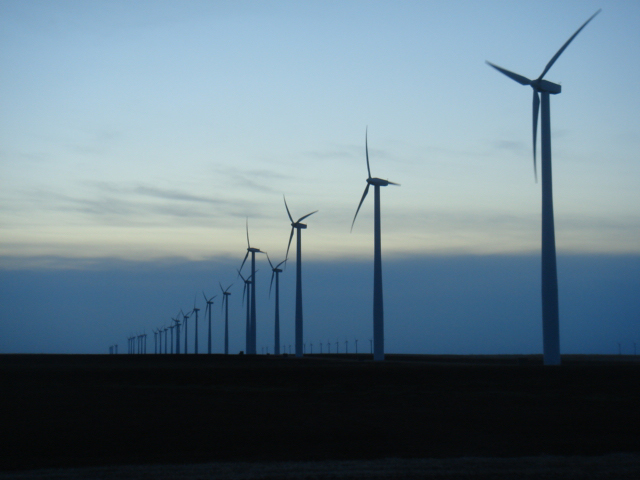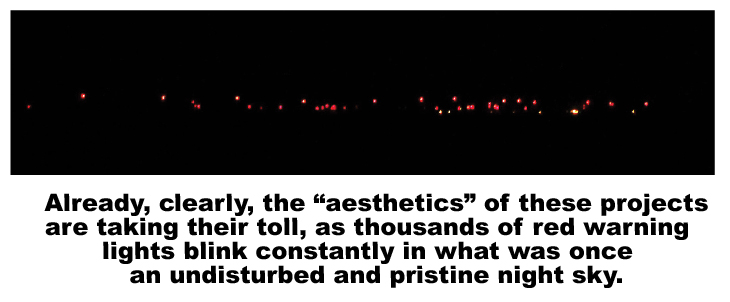‘THE BIGGEST PUBLIC LAND GRAB’
The ‘Green Energy Boom’ & Mainstream Environmentalism
Sometimes the endless open spaces of the West impress me most when I can’t see them at all.
One night when I was a ranger at the Arches National Park campground, I encountered a woman so terrified she could barely speak. She was from New York City, camping for the first time in her life, and had pitched her tent next to the campground “comfort station.” She felt comforted by the 200 watt security lights. When our generator failed that evening, the lights in the toilet went out as well and the woman was on the verge of a breakdown. Through stifled sobs, she explained that she had never been in total darkness before.
“Never?” I repeated.
“Never!” she replied.
What a tragedy. I can’t imagine anything more breathtaking than a night in the desert or out on the high plains or, best of all, up on the flank of some mountain, with nothing but a big dome of starlight and moonshine to show the way. There are still places out here where you only realize just how empty and untouched parts of the West are after the sun goes down. It’s the absence of lights. I can still name a few places, even in 2013, where I’m stunned by the perfect darkness.
Those light-less vistas are getting rarer every year as more and more development comes to the rural landscape. Not long ago, I was up at Arches at night for the first time in years and was shocked at the changes. I once loved doing night patrols when I was a ranger and practically wallowed in the dark of the desert evenings. Even on the higher ridges, there was a notable absence of horizon glow. All that has changed—it’s easy to discern the city of Grand Junction, 70 miles east as the crow flies. And now even Moab brightens the night. The 2000 foot cliffs of Moab’s West Wall practically glow with reflected light from the city.
A few hundred miles north of Moab, satellite images recently picked up an odd glow near the Canadian border in North Dakota. Photo analysts were puzzled at first; the glow suggested a metropolitan area comparable to Denver. But there’s no city within hundreds of miles.
What the night images revealed were gas burn-offs and drill rig lights from thousands and thousands of gas and oil wells that have been developed by the oil and gas industry in the last few years. Environmentalists were shocked and a national movement to shut down fracking makes headlines daily.
But go elsewhere, from the Great Plains to the Intermountain West to the Mojave Desert, and you can’t miss another industrial blight, on a scale comparable to North Dakota, if not bigger. It is taking a dramatic toll on the landscape, and becoming more pervasive by the month. And worst of all? It proceeds with only minimal opposition from the mainstream environmental community.
The Interior Department is leasing vast acreages of public land for the development of wind and solar projects. These aren’t mom & pop proposals to build rooftop panels; instead, they are being planned and constructed on a scale that should stagger the sensibilities of anyone with an environmental conscience. They represent the wholesale destruction of vast areas of the West.
The money behind Big Wind and Big Solar comes from Big Money. Many of the corporations investing millions of dollars in this public land grab for green energy are names we know—
* British Petroleum (BP), who plans a 48,000 acre wind farm in northwest Arizona.
* Nextera, an energy giant based in Florida, builds fossil fuel, nuclear plants, wind and solar farms. They recently destroyed a bald eagle nest in Ontario, Canada to make way for a wind farm.
* Duke Energy builds coal and nuke plants but are testing the green energy market in Wyoming and Texas. They want to build the Searchlight Wind Project in the Mojave Desert.
* Pattern Energy built the Spring Valley Wind Farm next to Great Basin National Park, Nevada and the Ocotillo Wind Express Wind Farm near Anza Borrego State Park, California. They are owned by the Carlyle Group, with ties to coal, oil and military (Iraq oil wars)
* The search engine giant GOOGLE recently announced plans to invest $55 million in a Mojave Desert wind farm.
The driving force–an economic one–behind wind development is the Wind Production Tax Credit . It was due to expire at the end of 2012. But a last minute deal to extend the tax credit kept it alive. A letter supporting the Wind Production Tax Credit certainly helped. It was signed by The Sierra Club, Natural Resources Defense Council, The Wilderness Society, Defenders of Wildlife, The Nature Conservancy and the Audubon Society. And so, while there is still serious debate that these “green” developments can even begin to make a dent in our insatiable hunger for energy, the subsequent environmental damage to public lands cannot be understated. And yet suddenly, environmentalists don’t seem to notice…or care.
Opposition to the tax credits and to the “green energy” steamroller has been left to a handful of honest and dedicated grassroots local organizations with a lot of courage and limited funds like Basin & Range Watch, the Desert Protective Council, the Center for Biological Diversity and Western Lands Project (look for list of groups who support and oppose this elsewhere in this issue).
Kevin Emmerich and Laura Cunningham, founders of the very grass-roots group Basin and Range Watch have recently wondered where their allies went. They’ve been fighting plans to exploit large parcels of desert land in Nevada and California from solar projects and have felt a bit lonely. They noted recently:
“Seems like 20 or 30 years ago, folks were concerned about protecting their local places, that specific mountain, the river nearby, those particular named canyons near where they lived, and the wilderness they hiked in. Today the shift among environmentalists has highlighted the global, the abstract, even the corporate model of ‘saving the Earth.’ We are often lectured by this new hybrid of industrial green energy environmentalists about how our attempts to slow down these large industrial energy developments will expedite the warming of the planet and the extinction of the polar bear. We find it ludicrous that these same people would support actions that could lead to the extinction of species like the desert tortoise in an attempt to save the polar bear. Who told them that they were justified in choosing which species get to survive and which do not?”
Last year, they attended a local BLM scoping meeting for the NextLight Silver State South project. They could not help but notice all the empty chairs. Their old nemesis, the ATV crowd was there in full force to protest the construction and to speak in defense of the desert tortoise, but members of the green community were conspicuously absent.
Emmerich and Cunningham observed, “One by one, the big name environmental organizations fell like Dominos.”
As Emmerich noted, some of the Big Greens insist that the loss of habitat and the destruction of the deserts and mountains and plains from these “green” projects is the price me must pay—the necessary evil—to “save the planet.” They insist that these are the kinds of regrettable choices we must make to keep climate change from turning Earth into another Venus. If I really thought that was their motivation, I might just go along .
But it’s not.
Instead this is about the mainstream environmental movement insisting–if you can believe this—that we can GROW our way economically out of this impending global disaster.
The Natural Resources Defense Council (NRDC), one of the groups that signed the letter of support for the wind tax credit, said recently, “Reducing global warming pollution will have an imperceptible effect on economic output….We can stave off the biggest environmental and humanitarian crisis without disrupting economic growth.” NRDC, in fact, believes we can expand the economy and fix the environment simultaneously. In other words, at least some of us can save the earth and get stinking rich at the same time.
It’s embarrassing, it’s insane and it’s wrong.
Yet most of the major environmental groups stand shoulder to shoulder with this kind of twisted and dangerous logic.
There is none of the urgency expressed recently by Sir David Attenborough, one of the world’s most respected environmentalists who fears we stand at the edge of a very real brink.
He noted last week, “We are a plague on the Earth. It’s coming home to roost over the next 50 years or so. It’s not just climate change; it’s sheer space, places to grow food for this enormous horde. Either we limit our population growth or the natural world will do it for us, and the natural world is doing it for us right now.”
And there is none of the honesty expressed by Wendell Berry who reminds us:
“…this is what is wrong with the conservation movement. It has a clear conscience….To the conservation movement, it is only production that causes environmental degradation; the consumption that supports the production is rarely acknowledged to be at fault. The ideal of the run-of-the-mill conservationist is to impose restraints upon production without limiting consumption or burdening the consciences of consumers.”
In the end, I struggle to take mainstream environmentalism seriously. They speak in defense of the land and the water and the air and the habitat that resides within or upon them. They claim to be worried about the survival of the planet itself. But really? Their opposition to environmental damage is frequently based upon a flawed, irrational, erratic, pick-and-choose nod to aesthetics. Consider…
They fight tooth and nail to oppose the extraction of oil and gas in North America but stay silent on the issue of consumption, failing to even acknowledge the connection.
They condemn habitat loss from energy exploration but somehow find a way to ignore the greatest destroyer of habitat loss–population growth and the expansion of Urban America. (When a once wild section of desert in southern California was opened to massive recreational use and a mountain lion attacked and killed a bicyclist, there wasn’t a Sierra Clubber in sight to speak in behalf of the cougar—green groups defend wild animals until they start eating their members.)
They claim to support wilderness and then do everything they can to turn it into a money machine via an obscene cash cow–the amenities/tourist economy that demands, by definition, the massive consumption of fossil fuels.
And remember those lights that could be seen from outer space? Those burning gas flares in North Dakota and the illuminated rigs? The same night skies are in jeopardy from “alternative energy” projects as well, and they continue to expand exponentially across the American landscape. As hundreds and thousands of wind turbines are proposed, planned and built across the Great Plains and the Intermountain West to the California Mojave and the Pacific Coast, nobody knows what their effect will be on the wildlife. But because the impacts come from “green energy,” few care.
But at night…Already, clearly, the “aesthetics” of these projects are taking their toll, as thousands of red warning lights blink constantly in what was once an undisturbed and pristine night sky. So much for the aesthetics of a harvest moon on the West Desert.
Despite the contradictions and the hypocrisy, do aesthetics matter? Of course they do. Would we ignore graffiti on the ceiling of the Sistine Chapel? No. But would we complain only if the vandals used ‘red’ spray paint? Would Krylon ‘green’ ’ somehow provide an acceptable alternative? Of course not.
Would we have the right to condemn the vandalism of the Sistine Chapel if we were off elsewhere, painting mustaches on the Mona Lisa? This is precisely the hypocrisy of the environmental mainstream when it goes ballistic over one form of vandalism while turning a blind eye to their own.
The global threat that mainstream environmentalists fear is real; for them to trivialize that threat by embracing such a dubious solution is an insult to the planet they seek to save. Whether there is ANY real solution now is doubtful, but to take the easy way out of this mess by becoming the enemy they claim to oppose is surely the beginning of a very bad end.
POSTSCRIPT: These green groups actually signed on to a letter with the American Wind Energy Association requesting the the Wind Production Tax Credit be extended. Here is the list:
The Wilderness Society, National Audubon Society, Sierra Club, National Parks Conservation Association, Western Resource Advocates, Natural Resources Defense Council,Defenders of Wildlife, Nevada Conservation League, Nevada Wilderness Project and Sonoran Institute
The letter can be referenced here:
http://wilderness.org/
TO CONTACT THE OPPOSITION & OFFER YOUR SUPPORT:
BASIN & RANGE WATCH: http://www.basinandrangewatch.
DESERT PROTECTIVE COUNCIL.: http://www.dpcinc.org
Both are also on facebook
To read the PDF version of this article, click here.
Don’t forget the Zephyr ads! All links are hot!











The effort to preserve economic growth by switching from fossil fuels to massively destructive wind farms and solar plants is “switching drugs;” no different in principle from the cocaine addict’s effort to cling to his high by switching to marijuana. All us old-time drug & alcohol counselors know it’s a delusional strategy, bound for destruction. No different when it comes to our addiction to cheap energy.
The drug analogy is perfect ’cause we’re not paying for the stuff either; without fed funny money, big wind and solar get no investors, and last I checked we’re still running a trillion in the hole every year. All for pathetic little part-time power plants. Can’t wait to hear the aging big greens try and explain all the broken mirrors to their kids.
Whatever happened to the scared woman in the dark?
@ Eric…The woman was so traumatized, I finally brought her a big candle and a lighter. She survived.
i’ve become a broken (w)record: the several-billion-gorilla in the room practically no-one’s talking about is
HUMAN (OVER)Population. the underlying cause of most, if not ALL our environmental and threats-to-the-planet problems.
< ZPG for a long long time, then maybe we can switch to simply ZPG.
For years everyone said look at Germany, they have the right idea. Now when we actually/finally start do something about it here people come out of the woodwork against it.
Could it be possible that by using wind farms we get a little closer to cutting our need for coal and perhaps even edge closer to draining Lake Powell?
Should we kill the wind farm and continue fouling the air with outdated energy producing methods?
Do we dislike wind farms as much as open pit mines, tailings, and bursting ponds of toxic waste?
If so we should continue embracing business as usual.
This is one of the most cohesive articles I’ve seen on energy sprawl hypocrisy. Good work.
I call the wind power situation “blight for naught” because it doesn’t even reduce CO2 on balance. Germany’s futile Energiewende may as well be called EnergieWIND, but the industry keeps ignoring its failures.
To achieve the relative density of Germany’s 30,000 wind turbines, America would have to build about 826,000. We’re already pushing 60,000 and it’s ugly enough. Where are the real environmentalists now?
Rich Mack wrote: “For years everyone said look at Germany, they have the right idea. Now when we actually/finally start do something about it here people come out of the woodwork against it.”
Germany is a poor example because Energiewende has done little in terms of CO2 goals. The 1998 Darmstadt Manifesto (lamenting all the desecration) was prescient. All they’ve really done is ruin their rural scenery and cut down a lot of trees. Look up: germany+energiewende+co2+emissions
You and others keep ignoring the massive physical blight of these machines, showing many traits of AGW-deniers (just a different tribe). Big Wind is deeply embedded in fossil fuels, in case you haven’t noticed how they’re built.